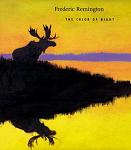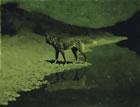
Feature Archive |
MoonlightingFrederic Remington's Nocturnes |
|
Frederic Remington, the greatest illustrator of the old American West, didn't have to be carried kicking and screaming into the 20th century. Handsome, clever, rich, he decided to show the Eastern critical establishment a trick or two. In the early years of the 20th century he undertook a series of nocturnes; a tricky subject for a painter both artistically and technically. The results are on display at the National Gallery of Art in Washington D.C., in a new show, The Color of Night, that brings almost thirty of these works together for the first time. Young Frederic, the son of a Civil War hero, aspired to a military career, but his talent for drawing led him to Yale University where he majored in art and played football. In the spring of 1883 he moved west, trying (and failing) to run a sheep ranch and then a saloon, all the time sketching the people and landscapes around him. When Harper Brothers, the New York magazine publishers, bought some of these sketches, Remington was on his way to becoming the preferred observer of western life for eastern audiences. Before he reached his fortieth birthday, Remington had become hugely successful as an illustrator, a sculptor and a writer, but critical recognition eluded him. Like so many of America's immensely talent popular entertainers, he wanted to be taken seriously as an artist by the eastern elites. The outbreak of the Spanish-American War unexpectedly offered him the opportunity to view military combat firsthand. But war is an ice cold shower for artists: think of what the Napoleonic wars did to Goya. Once on the ground in Cuba, visions of the heroic spectacle his father had described the Civil War as soon vanished, to be replaced by sketches of guerrilla warfare, prisoner of war camps and Spanish atrocities for William Randolph Hearst's New York Journal. This war inspired a new school of gritty, honest realism in American literature - most notably in Stephen Crane's work - so it is not surprising that it had a similarly clarifying effect on Remington. Back in New York in 1899, he was impressed by an exhibition of moonlit views of California missions by Charles Rollo Peters, who had in turn been influenced by James Whistler's nocturnes. Not long after, Remington undertook his first two nocturnes, intended as illustrations of his novel The Way of the Indian. Pretty Mother of the Night-White Otter is No Longer a Boy is a coming of age picture of two exultant young braves on horseback praying under the majestic moon. By cutting out all the unnecessary details, which had made him such an effective and popular illustrator, Remington posed rather than answered questions in the minds of the viewers. "Cut down and out-do your hardest work outside the picture, and let your audience take away something to think about - to imagine." Paradoxically, by leaving his narratives incomplete, fragmentary and unresolved, he further engaged his viewers. What did the cowboys and Indians, the settlers and the rustlers, do from dusk to dawn in the mountains and on the Great Plains of the West? On the evidence of these paintings, they never slept, but searched ceaselessly for friends or foes, meditated before battle, listened for approaching danger. Remington painted Americans on sensory high alert, resolute and ready. In a surprising way, the population of these paintings are a variant of American pragmatists questioning in order to survive. Who comes here?, the title of one of the works, could serve as the title of the whole suite. Another painting, The Story of Where the Sun Goes, reminds us that these philosophers told tall tales as well, stories which answered the questions of the young about the origins of all things, the source of both philosophy and religion. As I walked through this surprisingly satisfying show, I felt myself thinking more than once of memorable scenes from John Ford westerns such as The Searchers and She Wore A Yellow Ribbon, which were in fact inspired by Remington. In An Argument with the Town Marshall, one can imagine the young Gary Cooper or John Wayne on his trusty horse as the lone representative of law and order, confronting the eight desperadoes each outlined against a different lighted doorway. If Ford and his cinematographer studied Remington, what we see in this exhibit goes well beyond the comfort level of the conservative Hollywood in the thirties and forties. Even in the fifties, The Hungry Moon, with its three huddled figures skinning and cutting up a buffalo which lies stark on the snow under the moonlight, would have found proved too graphic and disturbing for a mass audience. Remington worked for most of his career in black and white, but these paintings show him to be an unexpected master of color expressionism. We expect to see fear and anger, and we do in The Grass Fire, with its difficult-to-paint firelight and moonlight. But the comic realism of the two palavering Indians in The Gossips is an unexpected gem of sarcasm in reds and yellow. Elegies are what Remington does best. The sun is going down on a vanished culture and way of life in such masterpieces as Evening on a Canadian Lake, Sunset on the Plains and Coming to the Call. This last, in which a solitary moose is outlined at the edge of a lake while a hunter almost hidden from view takes aim, ranks with Winslow Homer's masterpiece Right and Left as one of the great farewells in painting. The National Gallery website has an online feature which allows everyone to view brilliant, high definition images from the different stages of Remington's career, as well as many of the paintings in the show. The text, which is adapted from the catalogue, is example of how first-rate art historical scholarship and savvy educational expertise can be put in the service of the broader appreciation and understanding of the American experience.
 Exhibition Catalogue Frederic Remington: The Color of Night |
Sample images from the show:  No poster available  Buy poster  Buy poster  No poster available  Buy poster  No poster available  Buy poster  Buy poster  No poster available |
Past Articles
March, 2003
Magnificenza! Titian and Michelangelo, Manet and Velazquez, by Joseph Phelan
February, 2003
Masterful Leonardo and Graphic Dürer, by Joseph Phelan
January, 2003
Favorite Online Art Museum Features, by Joseph Phelan
Studies for Masterpieces, by John Malyon
2002
Advent Calendar 2002, narrated by Joseph Phelan
Portrait of the Artist as a Serial Killer, by Joseph Phelan
Renoir's Travelling, Bonnard's "At Home", by Joseph Phelan
The Philosopher as Hero: Raphael's The School of Athens, by Joseph Phelan
The Greatest Works of Art of Western Civilization
Celebrating Heroes; Celebrating Benjamin West, by Joseph Phelan
Chasing the Red Deer into the American Sublime (Education and the Art Museum, Part II), by Joseph Phelan
Planning Your Summer Vacation, by Joseph Phelan
Education and the Art Museum, Part I, by Joseph Phelan
Unsung Griots of American Painting, by Joseph Phelan
The British Museum COMPASS Project, interview by Joseph Phelan
Robert Hughes, Time Magazine Art Critic: Biography and Writings
2001
Software review: Le Louvre: The Virtual Visit on DVD-ROM, by Joseph Phelan
Tragedy and Triumph at Arles: Van Gogh and Gauguin, by Joseph Phelan
Her Last Bow: Sister Wendy in America, by Joseph Phelan
Love, Death and Resurrection: The Paintings of Stanley Spencer, by Joseph Phelan
Who is Rodin's Thinker?, by Joseph Phelan
Celebrations North and South, by Joseph Phelan
Rubens and his Age, by Joseph Phelan
Great Reproductions of Great Paintings
The Passion of Christ, by Joseph Phelan
Edouard Manet: Public Spaces, Private Dreams, by Joseph Phelan
Henry Moore and the British Museum: The Great Conversation, by Joseph Phelan
2000
Notorious Portraits, Part II, by John Malyon
Notorious Portraits, Part I, by John Malyon
The Other Michelangelo, by Joseph Phelan
The Art of Drawing, by Joseph Phelan
Poussin and the Heroic Landscape, by Joseph Phelan
Great Art Museums Online, by Joseph Phelan
Venetian Painting and the Rise of Landscape, by Joseph Phelan
Forbidden Visions: Mythology in Art, by Joseph Phelan
Themes in Art: The Passion of Christ, by Joseph Phelan
Web site review: Christus Rex
Web site review: National Gallery of Art, Washington, D.C., by Joseph Phelan
Online exhibit review: Inuit Art: The World Around Me, by John Malyon
Poll: Who is Producing the Most Interesting Art Today? (Results)
Poll: Who is Producing the Most Interesting Art Today? (Part II)
1999
Poll: Who is Producing the Most Interesting Art Today? (Part I)
Spotlight on The Louvre Museum
Spotlight on Impressionism
Spotlight on Optical Art
Spotlight on Animals in Art
Spotlight on Surrealism
Spotlight on Sculpture
Spotlight on Women in the Arts
Spotlight on The Golden Age of Illustration
Spotlight on Vincent van Gogh
Spotlight on Great Art